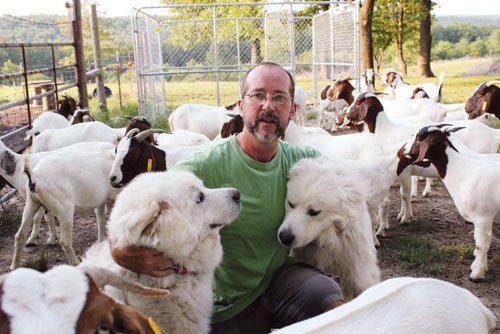Raising Goats
"Raising goats is an enjoyable and profitable adventure"
Goats are easy to handle, excellent at foraging and gives moderate levels of milk.
Goats are also very profitable and a good way for a small farmer to make some good money. I love working with my goats every day and there is nothing more comical then watching your kids playing in the field.

I'm given you a lot of good information and it will surely help you get on your way to being a profitable goat farmer.
But I'd also like to share an excellent resource that I purchased and found very useful. The Boer Goats Profits Guide is an excellent source of guidance that can help you too. Marc is a good ole country man that has done his research Click Here to find out more!

Goats are ideal dairy animals for a family or small farm. Their milk has great flavor and nutritional value compared to cow's milk.
In some ways, goats milk is far more superior then cows milk. Some people are allergic to cows milk and insist on drinking goats milk instead.
Naturally homogenized Goats milk, has fat particles that are so small they do not separate from the rest of the milk and is easier to digest.
Also, Goats milk is less likely to provoke an allergic reaction. So you might want to consider raising goats rather then having a milk cow. Goats require less space.
One of the most important considerations when purchasing a dairy goat is milk production. There are different breeds that are available. Many are satisfactory producers, but you do not have to purchase a purebred to get good productivity.
The best way is to buy a milking doe (a female already producing milk) with a history of good milk production.
When buying a goatling (young female), find out the productivity of its mother and sisters. This will provide an indication of how much milk you can expect from your young doe when she is ready to milk.
Some farmers start out with young kids, though they are less expensive, they are usually not a good choice for beginners.
The beginning farmer does not have the expertise to raise the young kids and they will probably have to purchase most of their feed. They will get no return on investment until the young goats give birth to kids and then they can start milking.
A good indicator of productivity is the goat's appearance
Look for an animal with the following characteristics:
1. large well rounded udder 2. Udder should be smooth elastic skin and no lumps 3. Has a straight back 4. Rib cage broad (can consume more food give more milk) 5. A long trim body 6. Bright eyes and a sleek coat sign of good health.
When raising goats, make sure the animal you buy has been tested for brucellosis and tuberculosis.
These diseases are rare among goats in the United States, but they are dangerous and can be transmitted to humans through milk.
Annual testing of milkers is essential.
Now, its time to talk about "how to milk a goat". Make sure you empty the udder completely at each milking. If you don't, milk production will decrease and the goat will give less milk each time.
The doe may stop giving milk all together until it bears another kid.
A lot of first time goat owners buy a bred doe that has never conceived before. This gives the new farmer time to get acquainted to caring for the doe.
Bucks have a strong smell
They are not usually kept unless farmers are interested in breeding goats. Most farmers will take their does to be bred at another goat farm. Bucks can be aggressive and often test their masters.
It's easy to take a doe to another farmers buck for breeding.
Now, it's very important to have good fences to keep your goats from places you do not want them. They usually will crawl through or under a fence. But, sometimes you may have a jumper.
Shelter from the cold and wind is also important.

How Much Do I Feed My Goat?
Raising goats require good quality forage that satisfies all of their nutritional needs. A good quality pasture for goats should include a variety of sprouts, branches, weeds, and tough grasses. This will help supply essential vitamins and minerals.
It's amazing how raising goats can clean and grown up pasture or dense woods. They will eat whatever they can reach. Usually up to 6 feet high on trees.
I usually go out with my chainsaw in the summer time and cut down a few trees and watch the goats eat on the green leaves till they are gone.
Then in the winter, I cut those trees up in firewood.
Legumes are also needed when raising goats. Lugumes provide essential proteins. In the winter, when good forage is not available, feed well cured hay.
Keep a good block of sulphur salt out for them and even a mineral block that they can lick.
Keep the goats hay off of the ground. They don't like eating hay off the ground. Build or buy a good hay rack and feed them twice a day. In the morning and evening.
While you are milking, give your doe two to four pounds of grain per milking. This provides additional protein in its diet. Feed a good quality grain usually with molasses, vitamins and minerals. Molasses give the grain a sweetness that the goats like.
If a good quality, fresh premixed feed is not available, buy a calf starter or horse grain mixture.
Do not overfeeding grain. It's dangerous and can lead to digestion problems. In extreme cases it may cause bloat which is a serious build up of gases that can cause death.
Feed grain only after the goats have eaten plenty of grass or hay. Feed it as only a supplement. Ration the grain out so that each goat gets its fair share. Putting the goats in separate stalls or lock them in separate feeding slots in front of a common manger is a good practice.
The stomach of a goat can be disturbed by changes in its diet, so feed your animals at the same time each day and make feeding changes gradually.
It is especially important when changing feeding habits from winter time to spring.
Always have plenty of fresh, clean water. It is important to any milk producing animal. The more a goat drinks, the more the feed will be changed into milk.

Raising Goats? Consider the Breed!
Nubians are known for their content of their milk and butterfat.
Saanens are gently and great producers
Toggenburgs are affectionate, hardy, and excellent foragers. They usually eat less then other breeds and are moderate milkers.
Grade Goats usually sell cheaper but they can produce as much milk as purebreds. If there is a demand for Purebreds in your area, they can be a good investment.
Just a small but very important note about raising goats. They are very curious animals and are always looking for ways to escape their boundaries.
So, when raising goats, make sure your fences are in mint condition and can hold this animal. They mainly will try to crawl through or under a fence. Sometimes you will have a jumper!
Return to Raising Livestock Return from Raising Goats to Self Sufficient Farm Living Homepage







